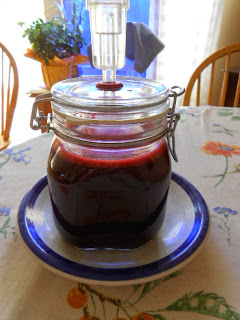Ferment "failures" for the most part, happen because too much oxygen gets into the jar, under or around the air-lock lid or other device, and allows bad yeasts and molds to get a hold of the food product. Lactobacillus bacteria and the good yeasts need anaerobic (oxygen free) environment to flourish, reproduce and make lactic acid and the other enzymes that are good for us. The bad yeasts and molds grow and thrive with oxygen. So, whatever device you use, make sure that it can keep air out and still allow carbon dioxide to also escape.
Interested in notching up your diet and health? Try fermenting foods, Friendly microbes that can supercharge your food and your health, naturally. I sell milk kefir grains, sourdough starter flakes, kombucha scobys, dairy strainer cloths and Prills for raising tap water's ph. Please email me with questions....... at....joannesmithseal@gmail.com
Thursday, October 31, 2013
Update: Sauerkraut and Vegetable Ferments
I've just done some reading about the importance of keeping oxygen out of vegetable ferments like sauerkraut and giving ferments more time to ferment without premature refrigeration. Thought would pass this information along to my class participants.
For one thing, this time of year it is not necessary to put ferments into the refrigerator 5 days after the ferment time. With weather temperatures cooling down and most home temperatures cooling down also, this step isn't necessary. The "experts" are concerned that home vegetable fermentors are not allowing enough time for the full fermentation process to take place when they put the jars of vegetables into refrigeration too soon. Some are suggesting that room temperature fermenting should take at least a week or more before removing air-lock lids and securing more permanent lids and putting in storage. They say, allowing longer ferment times at room temp. and then storing in cool dark places for up to 6 months or more produces a much better and more nutritious sauerkraut or pickle without "failures" (mold and other bad microbe pollution).
Ferment "failures" for the most part, happen because too much oxygen gets into the jar, under or around the air-lock lid or other device, and allows bad yeasts and molds to get a hold of the food product. Lactobacillus bacteria and the good yeasts need anaerobic (oxygen free) environment to flourish, reproduce and make lactic acid and the other enzymes that are good for us. The bad yeasts and molds grow and thrive with oxygen. So, whatever device you use, make sure that it can keep air out and still allow carbon dioxide to also escape.
Ferment "failures" for the most part, happen because too much oxygen gets into the jar, under or around the air-lock lid or other device, and allows bad yeasts and molds to get a hold of the food product. Lactobacillus bacteria and the good yeasts need anaerobic (oxygen free) environment to flourish, reproduce and make lactic acid and the other enzymes that are good for us. The bad yeasts and molds grow and thrive with oxygen. So, whatever device you use, make sure that it can keep air out and still allow carbon dioxide to also escape.
Monday, October 28, 2013
Beet Kvass; green printout error
The way it is printed, I did not specify what size bottle for the beet ferment. It should have said to use a 2 quart bottle packed with chopped beets and 1 TBS salt dissolved in 1 quart of chlorine-free water. Some might have interpreted the recipe to use 2TBS of salt with a 2 quart bottle.
The general rule with Sally Fallon recipes is usually 1 TBS salt with 1 quart of vegetables and water but this Kvass recipe works with 2 quart bottle and only 1 TBS salt.
I hope that clarifies the directions. I love my beet kvass and have found many people making it and using it regularly. It was from a couple of those fermentors that I understood my error. They were getting kvass that was too salty.
Hope this helps.....now is good time to harvest those beets and make kvass. After I have made a second ferment from a batch of chopped beets, I usually cook some of them up and serve with melted butter, a little bit of sweetner and some vinegar. Tastes like my mother's pickled beets when she packed them with sugar, cloves, distilled vinegar and then "water bath" cooked them. I Iiked the flavor of my mother's pickles but healthwise, they were "dead".
Better to get the fermented juice (living) from them first then cook them. Maybe some people like the crunchy raw fermented beets as they are, but they are too crunchy for me. I put the rest of the beets on my compost pile.
Subscribe to:
Comments (Atom)


